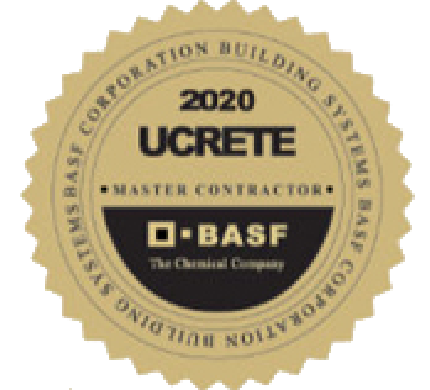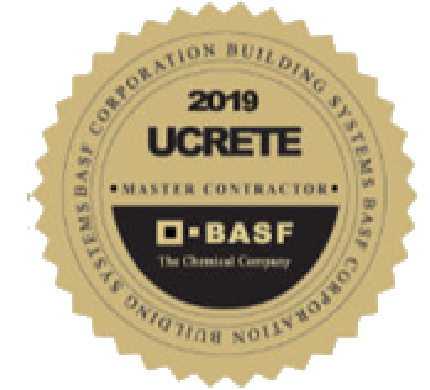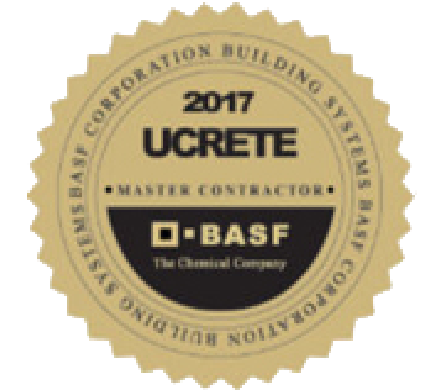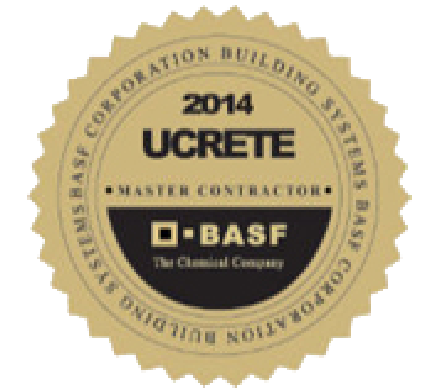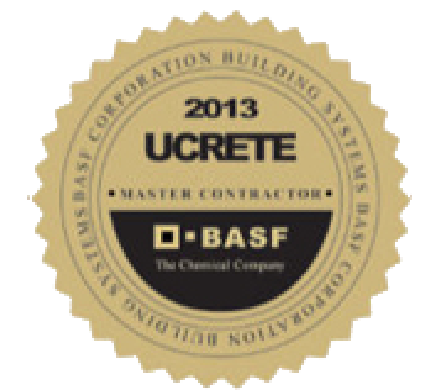Admixture – Product other than water, aggregate, or hydraulic cement that is added to a concrete mix before or during mixing to modify the properties of the mix or the cured concrete.
Aggregate – Granular material such as sand, gravel, crushed stone, crushed hydraulic cement concrete used with a hydraulic cement or polymer binder to produce Portland cement concrete and mortar or polymer concrete and mortar.
Alkali-aggregate reaction (AAR) – Chemical reaction in either mortar or concrete between alkalis (sodium and potassium) from Portland cement or other sources and certain constituents of some aggregates. Under certain conditions, deleterious expansion of concrete or mortar may result.
Alkali-silica reaction (ASR) – Chemical reaction between alkali in Portland cement and certain silica-containing aggregates.
Amine blush – Surface opalescence (blush) on surface of amine-cured epoxy films caused by reaction of amine with carbon dioxide and water in air; must be removed before top coatings.
Backer rod – Rigid item placed in joint to support sealant.
Benchmark – Reference mark on permanent object to indicate elevation or location.
Bleeding – The flow of mixing water within or to the surface or newly placed concrete or mortar.
Bleed Water – Water on a concrete or mortar surface resulting from bleeding.
Bond-breaker – Tape or other material used over joints or cracks to prevent bonding between concrete slab and flooring system and thus allow movement between them without damaging the flooring system.
Broadcast – Scatter in the air in all directions like sowing seeds.
Broadcast flooring – Unfilled resins (commonly) or aggregate-filled slurries into which aggregate is scattered by a seeder or manually in a raining manner into the wet uncured resin or slurry which then cures with the aggregate embedded in it.
Broadcast to saturation – Scatter aggregate into a wet matrix until no matrix wetness is oberserved (until no more aggregate can be embedded into the wet matrix).
Bug hole – Small cavity in concrete surface resulting from air bubble entrapped against form during placement and compaction of concrete.
Cant – Slanting with respect to a particular line.
Capillary Space – Microscopic channels on cured concrete that permits the movement of liquid water.
Carbonation of Concrete – Reaction of alkali in concrete or mortar to form a carbonate and weaken the concrete or mortar.
Cemetitious Coating – Paint or other covering used to protect or provide special properties (e.g., slip resistance or improved lighting) to concrete
Chain drag test – Method of determining concrete soundness by dragging a chain across it.
Chamfer – To cut a furrow.
Cold joint – Discontinuity resulting from a delay in placement of sufficient duration to preclude intermingling and bonding of the material in two successive lifts of concrete, mortar, or the like.
Composite – Combination of two or more materials differing in form on a macro-scale, each retaining its own identity with an interface between them.
Concrete – Composite material of binder and aggregate; in cured Portland cement concrete, the binder is hydrated Portland cement.
Construction joint – Joint in a concrete slab at the end of an individual placement.
Contraction joint – Joint sawed or tooled in concrete slab that creates a weakened plane to permit dimensional changes to occur without damage to the concrete.
Coving (cove) – Part of finished flooring system that terminates at floor edges by turning up abutments such as walls or columns to permit easier cleaning.
Dynamic Crack – Crack in concrete surface that changes in width as the concrete moves.
Efflorescence – White or gray powdery deposit on the surface of concrete caused by alkaline products in concrete migrating to the surface and reacting with carbon dioxide in the air.
Electrostatic Dissipative Flooring (ESD) – Coating/surfacing material that drains away electrostatic charges as they are developed.
Exotherm – Heat produced in a chemical reaction.
Feather – Reduce the thickness of a coating or resurfacer by tapering.
Fins – Narrow projections resulting from wet mortar flow through spaces in framework.
Hammer Test – Procedure for determining concrete hardness by tapping with hammer.
Honeycomb – Voids left in concrete where mortar incompletely filled spaces among coarse aggregate particles.
Hydration of Cement – The reaction of water with Portland cement to cure concrete
Hydraulic Cement – A cement that sets and hardens by interaction with water and is capable of doing so underwater, for example, calcined gypsum, the set of which is accelerated by the addition of other materials.
Hydrocarbon Test – Procedure for detecting contamination by hydrocarbon contamination of surface by their fluorescence under ultraviolet light.
Isolation (expansion) joint – Joint in concrete slab to permit completion freedom of movement between the slab and vertical or horizontal elements (e.g., walls and columns).
Joint Fillers – Pre-molded materials (e.g., asphalt or bituminous-saturated felt boards or expanded (foamed) thermoplastics.
Joint Sealant (Sealer) – Liquid material applied as a topping over a joint filler after the concrete has been placed and cured.
Keying (Keying In) – Process by which cured concrete is removed to create a termination border for a fluid-applied flooring system.
Laitance – Thin, weak, brittle layer of cement and aggregate fines on a concrete surface, usually caused by overworking the surface and/or excess water in the mix.
Lap Length – The length of overlapping steel reinforcing bars.
Material Safety Data Sheets (MSDS) – Printed information concerning the hazards of materials required by OSHA (Occupational Safety and Health Administration).
Mica – A laminar mineral, aluminum potassium silicate.
Mildew – Discoloration caused by growth of fungi.
Monolithic – Term used to describe a seamless polymer flooring system.
Mortar – A mixture of cement paste and fine aggregate.
Nap – Soft, fibrous material.
Neat Resin – Unfilled resin (without aggregate or other filler)
Non-skid coating (non-slip) – Coating that contains coarse particles that impart a rough, abrasive surface that resists sliding of people and equipment.
Outgassing – Spontaneous discharge or air or solvent vapor from pores in concrete as the temperature is rising, may create pinholes in coating being applied.
Permeability – Rate of water vapor transmission through a unit area resulting from vapor pressure differences at a specific temperature and humidity.
Petrographic – Concerned with the science of rocks, their origin, structure, composition, etc.
Planarity – General evenness of a surface in an intended direction; may be sloped or level area.
Polymer – A high-molecular weight organic product consisting of many units or one or more small components (monomers) linked together.
Polymer Flooring – Liquid-polymer system such as a sealer, coating, or mortar that cures to form a solid film to provide repairs, protection, or enhancement to horizontal concrete surfaces.
Polymerization – Chemical reaction of two or more molecules (monomers) combining to form a large molecule (polymer). The new molecule has repeating structural units of the original molecules.
Ponding – Shallow area on a normally flat area of concrete.
Popout – Shallow, typically conical, depression left after a small piece of concrete surface has broken away.
Portland cement – Hydraulic cement produced by crushing, milling, and firing natural earth materials into clinkers and then pulverizing the clinkers with calcium sulfate (gypsum) to specified degrees of fineness.
Pot Life – Time after mixing in which coating that it can by applied satisfactorily.
Pozzolan – Natural mineral or artificial product that in itself has no cementious properties but may replace part of the portland cement in concrete mixes.
Profile – Surface contour; specific profiles are recommended for application of specific coating/surfacing systems to concrete.
Psychrometer – Instrument used to determine relative humidity and dew point.
Rebond (e.g., Schmidt) Hammer – Device with spring-driven mass that is rebounded off cured concrete; rebound height.
Recoat window (time) – Time period after application of a two-component, chemically curing coating during which it can be top-coated successfully.
Reflecting Cracking – Cracking that develops in a polymer system directly over a dynamic crack in the concrete.
Reinforcement – Fabrics or functional fillers that provide or enhance desired properties (e.g., strength) to a polymer flooring system.
Resin – General term applied to a wide variety of more or less transparent fusible products; a polymeric resin is used as a binder for coatings and surfacings.
Screed – Tool used to remove excess concrete to fill a form evenly.
Screwdriver Test – Method of determining the soundness of concrete by dragging a screwdriver across it.
Sealer – Liquid product applied to the surface of hardened concrete to prevent or decrease the penetration of liquid or gaseous media.
Segregation – Difference in the concentrations of components of mixed concrete (such as by settling or overworking) that result in non-uniform proportions.
Self-leveling flooring – Resinous or polymer cemetitious materials that flow out over a concrete slab to seek their own levels; they usually require termination strips rather than key-in terminations.
Skim Coat – Thin coat of resin or cement-mortar applied to smooth surface irregularities.
Splay – Slope
Slump – A measure of the consistency of freshly mixed concrete or mortar.
Slurry Flooring – Coating or resurfacing system, usually 100% solids, of resins and fillers that is flowable but not necessarily self-leveling, usually troweled to the thickness of the largest aggregate in the mix.
Spall – Fragment detached by concrete caused by weathering, corrosion of rebar, and expansion, etc.
Spatter (Concrete) – Surface deposits from splattered concrete mix.
Spoon cove – Cove of 1-inch diameter
Squaring up – Cutting around a section of deteriorated concrete with straight cuts that have all angles between adjacent cuts at least 90 degrees.
Squeegee – Blade, usually rubber, set with a handle used to spread materials smoothly across a surface.
Superplasticizer – Water-reducing admixture that can greatly reduce the W/C of a concrete mix.
Surfacing – Aggregate-containing polymeric coating, generally applied at thicknesses equal to or greater than a 1/16 inch (62.5mils)
Thick film coatings – coatings greater than 20 mils dry film thickness
Thin film coatings – Coatings no greater than 20 mils dry film thickness
Tie-rod hole – Hole left in concrete after tie-rods securing forms in place are removed.
Water Break Test – Qualitative test for surface contaminants, particularly, grease and oil, conducted by spraying a mist of water on the surface and observing for water break.
Water-to cement ratio –
W/C – Ratio of weights of water-to-cement (or cementitious material) in a mix expressed as a decimal.
Wet Edge – Fluid edge of a coating or concrete application to which the next stretch can be joined without forming a lap.
See a showcase of completed projects and contact our Indianapolis headquarters using the form below or request a free quote.
NEED A FLOORING CONSULTANT?
Call us now at 317-388-8000 or click the button to plan your project today

INDUSTRIAL FLOORING CASE STUDIES
MEAT PROCESSING FACILITY | INDIANA | UCRETE IF
MEAT PROCESSING FACILITY | INDIANA | UCRETE IF Heavy-Duty Ucrete IF Flooring When this Indiana meat processing facility shut down for the holidays in December, … READ MORECincinnati Candy Maker
Cincinnati Candy Maker Surface Solutions USA recently completed a 3000 square foot application for a Cincinnati candy maker. The maintenance shop required a white epoxy … READ MOREConcrete that Heals Itself
Concrete that Heals Itself Out-of-this-world ways to solve one of the flooring and construction industry’s most persistent challenges Grace Cathedral sits atop Nob Hill, on the … READ MORE
COMPANY AWARDS
